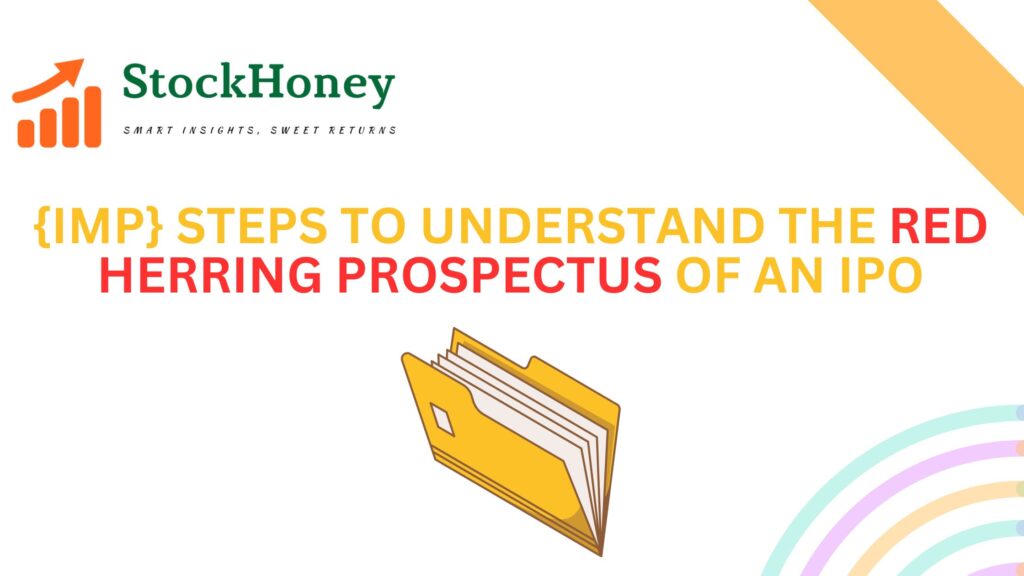Investment in an Initial Public Offering is always exciting to most investors, though it could be overwhelming if the investors are retail investors. A primary document one must read and understand for an investment in an Initial Public Offering is the Red Herring Prospectus or RHP. In this article we will simplify the complexity of RHP, to ensure that the retail investors understand the crux of RHP and guide them for a better investing decision.
What is a Red Herring Prospectus (RHP)?
RHP is an abbreviation for Red Herring Prospectus. This is a draft document submitted to SEBI by companies seeking an IPO. Unlike the final prospectus, it does not have pricing and the number of shares that would be offered in an IPO. But it does include the company’s business description, financials, major risk factors, and much more.
Why Retail Investors Should Read and Understand the Red Herring Prospectus (RHP)?
Most investors do not read RHP as they find it long and complex. However, RHP provides crucial information that can be used by a retail investor to make informed decisions. It is not just for institutional investors or financial analysts. In fact, reading the RHP can help in the following ways.
- You can determine whether the company aligns with your investment objectives.
- Help you know the stability and the growth potential of the company.
- The associated risks with the company or the industry in which the company operates.
Key Areas of the RHP
For a better understanding, let’s break down some of the key sections of the RHP. These are the areas that a retail investor needs to pay specific attention to:
1. Business Overview
Business Overview gives you the outlines of the company’s operations, business mode, its competitive advantage, and the source of revenue. It is important to know this because it gives you an understanding of what the company does, its industry, and its sources of income. Before investing in any of the IPOs check the following points.
- Is the business model of the company sustainable?
- Is there a demand for the products and services sold by the company in the market?
- Does the company have a competitive advantage and do these advantages differentiate the company from the competition?
2. Industry Overview
It gives you an overview of the industry in which the company operates, growth trends in the industry, challenges, and competitive landscape. This helps you understand the potential for growth of the company. In the industry overview check for the following points.
Growth trends in the Industry: The industry to which the company belongs, is it expected to grow in the coming years. For example, companies belonging to technology and renewable energy may offer potential growth opportunities.
Position in the Market: Is the company a market leader or a new entrant? In the case of a market leader, the growth is expected to be more sustainable.
3. Risk Factors
This is one of the most critical portions of the RHP as it identifies potential risks that may impact the performance of the company.
Business Risks: Factors that may have a direct influence on the operations of the company. For instance, supply chain issues and dependency on a single revenue source.
Regulatory Risks: Check whether the business is highly regulated, which may limit growth potential or cause additional costs.
Industry-Specific Risks: In some businesses, specific industries are susceptible to certain types of risk. For instance, patent expiration and regulatory approval create intense pressure on pharmaceutical businesses.
Hence, it is better to consider all these risks and then invest based on your risk tolerance level.
4. Balance Sheet/ Liabilities/ Shareholders Equity
Check the Audited Balance Sheet/ Liabilities/Shareholder’s equity for the last three years, this will provide an overall view of the health of the company.
What to look for?
Revenue Growth: Steady growth with increasing revenues reflects a healthy business model in place.
Profit margins: A higher profit margin will indicate efficient operation. Check for the trend in margin over the years to identify growth or decline in it
Debt Levels: Companies that have high levels of debt will continue facing issues in the long run, especially if the interest rates increase.
5. Promoters and Management
The section on Promoters and Management gives information about the people running the company. Experience and credibility of the promoters and top-line management are the most important determinants of the performance of the company in the future. Key points to look out for:
Experience: How long has the management been part of the industry and their track record?
Stake: Do the promoters have a stake in the company and its percentage? The higher the stake of the promoters, the better it is considered since a higher stake of the promoters shows that they have a greater commitment to the company.
6. Utilization of IPO proceeds
This section will let you know, how the company intends to use the money generated from IPO proceeds.
Growth-Related Investment: If the proceeds are utilized for expansion or R&D, then it would be a signal of future growth.
Debt Repayment: If the proceeds are used for debt repayment, it means although the debt repayment will help stabilize the company, it may not necessarily support growth.
7. Valuation and Peer Comparison
Though the RHP does not reveal the actual IPO price, it would usually contain several financial ratios and metrics like the Price to Earnings Ratio (P/E) and Enterprise Value-to-EBITDA Ratio for the investors to form opinions on its valuation. Comparing this with the company’s industry peers would tell you if such an IPO price is indeed fair.
8. Legal Proceedings
This section will show if there are any pending litigations, tax disputes, or regulatory cases against the company. Legal issues can pose significant risks if they impose significant financial penalties or operational constraints.
How to Use the RHP for Investment Decisions?
Reading the RHP is not about predicting what a company will look like in the future but assessing whether that company fits your investment goal or your risk tolerance. And here’s how to make the most out of the RHP:
Match the Company’s Profile with Your Goals: Decide if the business model, growth potential, and the associated risks of the company’s business are aligned with your investment strategy.
Review the Financial Condition: Look for stability and growth in financial indicators.
Assess the Risk: If you are not comfortable with volatility, then carefully consider the risks.
Peer Comparison: Check the valuation metrics and compare with similar companies in the same sector to know if the IPO is fairly priced.
Common Mistakes Retail Investors Make When Reading an RHP
Being aware of a few of the pitfalls while reading a RHP will save you from reading the RHP wrongly.
Missing the Risk Factors: Many retail investors focus on the growth factors while paying little or no attention to the risk factors. Always balance the company’s growth potential with the risk factors.
Overemphasis on financials: Though financials are important, great management quality and a good market position are equally vital for a company.
Misinterpretation of Valuation: Low valuation does not necessarily mean a good investment. Make sure that the valuation matches the growth prospects of the company.
Conclusion
The Red Herring Prospectus is the best source for retail investors looking to invest in IPOs. Retail investors can make better decisions based on sections such as Business Overview, Risk Factors, Financial Statements, and Use of Proceeds. It looks complicated at first, but when you take the time to learn about the RHP, you can improve your investment strategy and minimize potential risks.
Always remember – Invest in IPOs strictly based only on your financial goals.
Happy IPO Investing!
Related Information & Articles
Current & Upcoming IPOs in India
8 IPO Investment Strategies: Long-Term Growth
7 Common IPO Investing Myths Exposed
What IPO Subscription Status Reveals?


